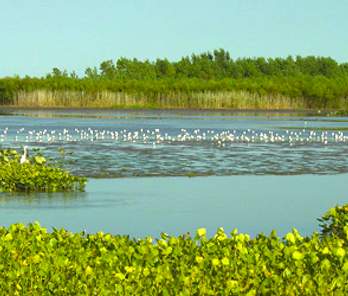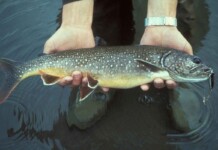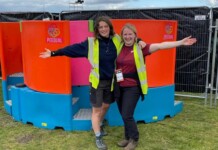 The northwest corner of Chicago, framed by the lanes of traffic along Interstate 94 and State Route 14, seems an unlikely address for wildlife. But across the street from a shopping center, on the banks of the north branch of the Chicago River, lives a thriving ecosystem called Gompers Park Wetlands.
The northwest corner of Chicago, framed by the lanes of traffic along Interstate 94 and State Route 14, seems an unlikely address for wildlife. But across the street from a shopping center, on the banks of the north branch of the Chicago River, lives a thriving ecosystem called Gompers Park Wetlands.
Jim Macdonald, local resident and volunteer caretaker, reels off a list of creatures he’s spotted. “Last summer I counted seven different species of dragonflies and five of damselflies,” he said. “There always were a few, but nothing like this richness. We got two loons last week. It’s rare to get them inland. There was a coot there yesterday. Mergansers, too. We also have herons.” Macdonald, a professor of anthropology at nearby Northeastern Illinois University, also has seen a snapping turtle, a coyote and muskrats.
The land, once dredged for commercial fishing and then filled with dirt and bricks as part of a mosquito abatement program, was excavated to its original soil level to expose any surviving plant seeds. Garden club members dug in 1,000 native plants, 35 species in all, including wild iris, cattails, sedges and arrowhead. In just three years, the wetlands has become a plentiful source of food and shelter for insects and animals.
According to the U.S. Environmental Protection Agency, wetlands are comparable in their biological productivity to tropical rainforests. They also greatly influence the flow and quality of water by acting as a tub or sponge to absorb, cleanse and then slowly release flood and surface water.
After a heavy rain last year, the area filled with 10 to 15 feet of water, some of it untreated sewage. The wetland processed organic wastes, retained nutrients and reduced sediments before releasing the water back downstream. However, the Chicago River is still rated “moderately impaired”: Officials warn against swimming in it or eating the fish.
The effect that this three-acre wetlands has on the river’s 60-mile-long journey through the city is minuscule, Macdonald acknowledges. But every little bit counts. “Anything we can pull out makes a difference,” Macdonald says. “I would like to see more restoration. I do believe that it is one way we can go to help restore healthy waterways and a healthier environment.”



















